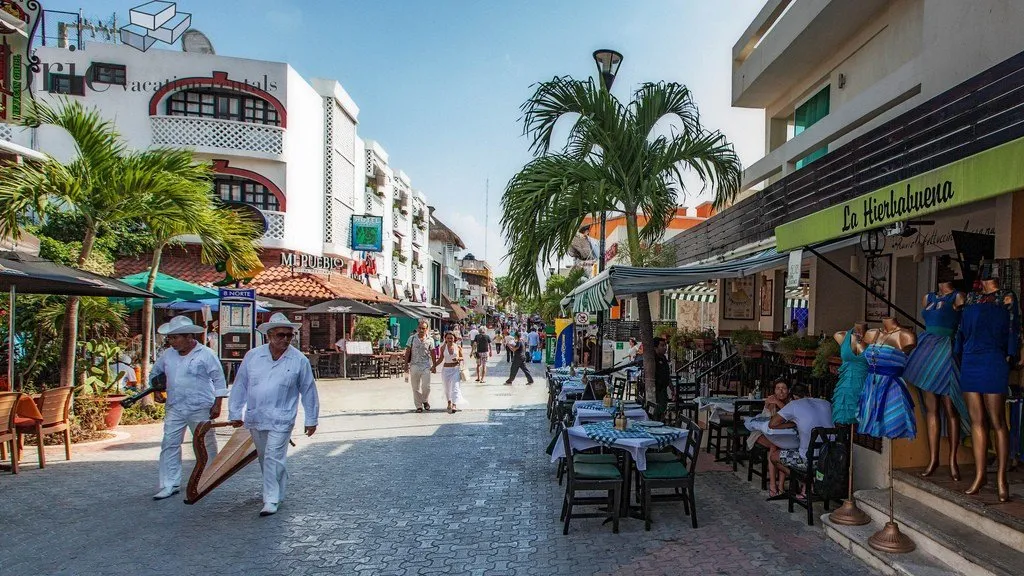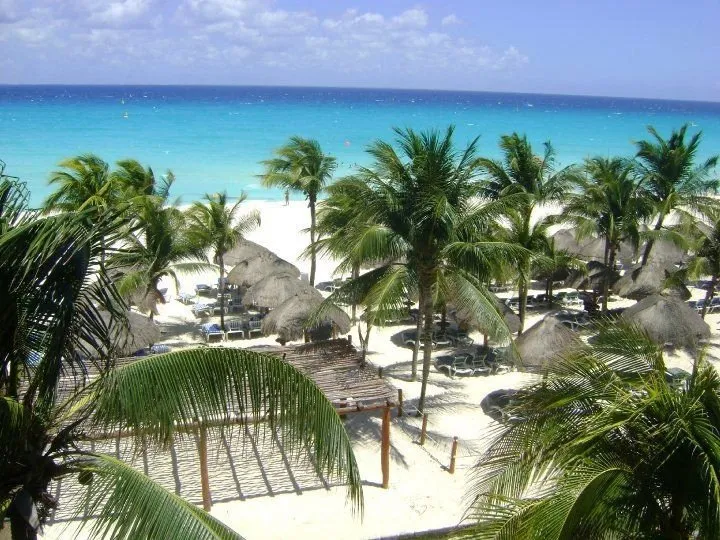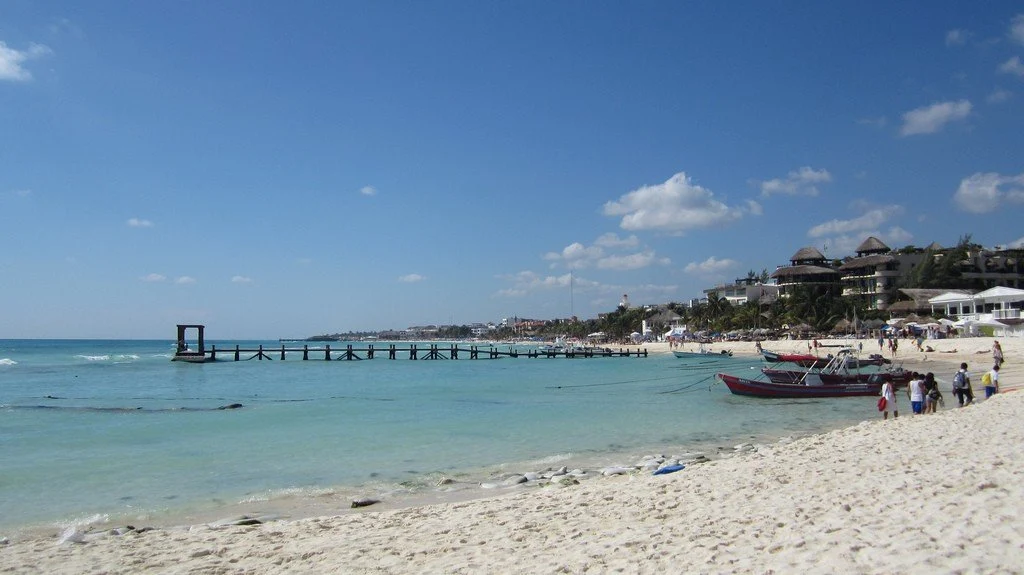Playa del Carmen is a Mexican resort located 64 km south of Cancun. It is much smaller and the atmosphere here is almost European. Until the early 1980s, Playa - as it is usually called - was a simple fishing village. Today it is one of the fastest growing communities in Mexico. Not only Mexicans, who can be found here on weekends, come here to rest, but many people from all over the world. Among other things, huge cruise ships moor here twice a week, replenishing the local population.
 |
| Playa del Carmen |
Basic Moments
Both Playa del Carmen and adjacent Playacar are located in the Riviera Maya, or Mayan Riviera as it is also called, about halfway between the large upscale resort of Cancun and Tulum, a picturesque Mayan fortress built on a cliff. The ancient Maya appreciated the beauty of these places long before the Spaniards arrived here in the 16th century, and the tourist boom began a few centuries later. Mayan ruins fill the shore; their largest concentration is observed around Playa del Carmen.
The pedestrian street Avenida 5 runs through the center of the town, where there are many boutiques, good restaurants and houses with interesting architecture. The heart of the town is the zocalo, the main square. To the west is Avenida Juarez; it has a bus station, a post office and several banks. North of Avenida 5 you will find most of the hotels, restaurants, bars and shops. The further you go along Avenida 5, the cheaper the restaurants and shops will become, and the less crowded the beaches will become. Streets (avenidas) are numbered 5, 10, 15, and so on, so street number 30 is not as far from Avenida 5 as it might seem.
 |
| Playa del Carmen |
Just south of Playa del Carmen is the purpose-built gated resort of Playacar, with an 18-hole golf course, large all-inclusive hotels, private rental apartments and executive areas. From the center of Playa del Carmen, you can get here by taxi in 5 minutes; there are many Mayan ruins around Playacar, and there is practically nothing to see at the resort itself.
Beaches
The Riviera Maya stretches south from Cancun to Tulum, with Playa del Carmen and Playacar nestled in the heart of the region. Here, the coast has white sand, and the water in the sea is crystal clear. The descent into the water is so gentle that the sea seems to be just a huge pool.
Most resort hotels are located along the coast, where the white sand is especially clean. The main beach of Playa del Carmen, with its bars and restaurants, narrows to the north and becomes less crowded. In front of the large yellow building of the Hotel Porto Real, the beach widens again; here, in one of the beach clubs, you can rent an umbrella and a sun lounger.
 |
| Playa del Carmen |
If you walk along the coast to the north for another 10 minutes, you will come to Coco Beach, where there are several restaurants and shops for divers. Nearby is Chunzubul Reef, where you can rent a boat from the locals and snorkel. Note, however, that most of the coral near the shore has been destroyed.
All the beaches around Playa del Carmen are open and free, you can get to them from the promenade - there are several entrances. However, the farther north, the more difficult it is to get to the beach - access through private areas is limited. It is best to go straight on the sand, as most of the paths that branch off the highway towards the coast between Puerto Morelos and Playa del Carmen end in a dead end.
Leaving the territory of the main beach, you will find yourself in the resort area: Playa Tucan, Mamitas, Shangri-La, Zubul and Coco Beach. In this part of the coastline, bars and restaurants line the coastline, so you'll always have the opportunity to refresh yourself. Lifeguards work on all beaches, but this is not a reason for carelessness; take precautions when swimming.
 |
| Playa del Carmen |
Even further north, the best beaches of the Riviera Maya begin again: the aptly named Mysterious Beach, Playa del Secreto (Playa del Secreto), and Paradise Beach, Playa Paraiso (Playa Paradiso); their width is 5 km. Sea turtles and crabs are frequent guests here. Unbeknownst to you, you will find yourself on Punta Maroma (Punta Maroma) and Punta Beta (Punta Bete); limestone formations and jungle here seem to be created by designers to delight the eyes of vacationers. If you come with children, you may like the part of the coast near the resort of Porto Real. Here, small thickets of coral form natural pools of warm water, where fish swim - safe and interesting for the little family members.
Many restaurants in Playa del Carmen turn into bars and nightclubs late at night. There are a lot of bars and clubs on Avenida 5.
What to See and Do
Cenotes
Cenotes are natural sinkholes formed by the collapse of the arches of limestone caves in which underground water flows. There are many of them here, and diving in them is a pleasure. The Scuba Cenote Club is run by Armando Elizalde and organizes trips to local cenotes.
Calle 6, bis 235. Tel: 984-131-23-91. www.scubacenote.com.
Diving
Diving in underwater caves, among stalactites, stalagmites and coral accumulations with the British-Danish club Dive Mike (Calle, 8, between Avenida 5 and Zona Federal Maritima; Tel: 984-803-12-28; www.divemike.com). Playa del Carmen also has many other dive shops to choose from.
Golf
Playacar has the best golf course on the coast - Playacar Club de Golf. Designer Robert von Hagge designed this championship course (par 72) in a dense jungle where the Maya once lived. The matches held here are spectacular, it is an honor to win them.
Playacar's courts can get really hot, so we recommend playing early in the morning or late in the evening. For games in the afternoon (after 14.00) prices are lower, www.palace-resorts.com/playacar-golf-club.
Excursion to the Jungle
You can ride a quad bike through the jungle, swim in the 18 m deep seine-te and climb ancient Mayan ruins - all this is included in the program of the two-hour excursion. ATV Explorer. Carretera, 307. Tel.: 984-873-16-26. www.atveexplorer.com.
Shallan-Ha Bird Park (Xaman Na Aviary)
At the aviary, visitors can walk among butterflies, colorful birds including parrots and toucans, flamingos and scarlet macaos, and exotic wildlife such as iguanas. Paseo Xaman-Ha, Playacar. Tel.: 984-873-03-30. www.aviarioxa-manha.com/english. 9.00-17.00 daily.